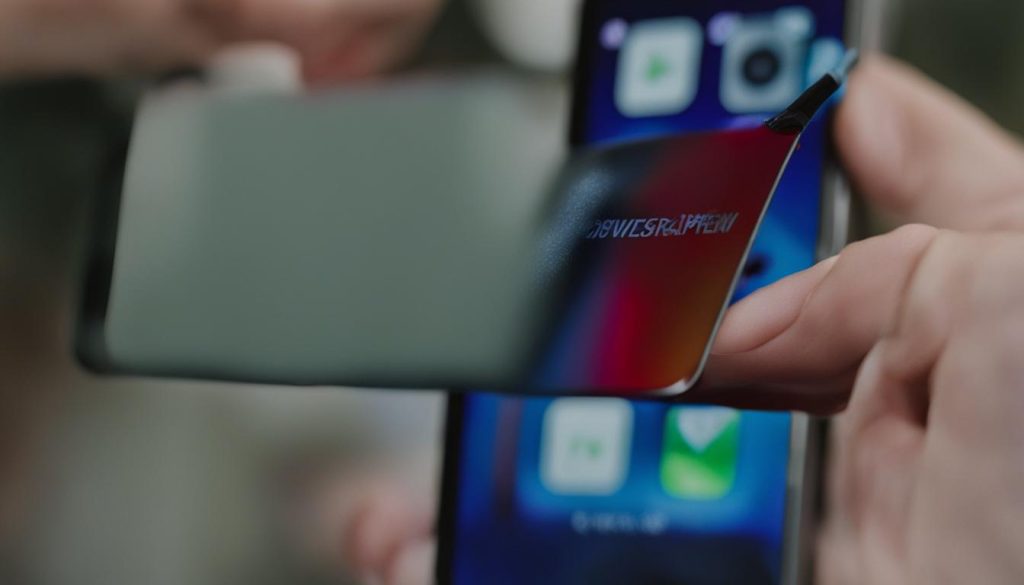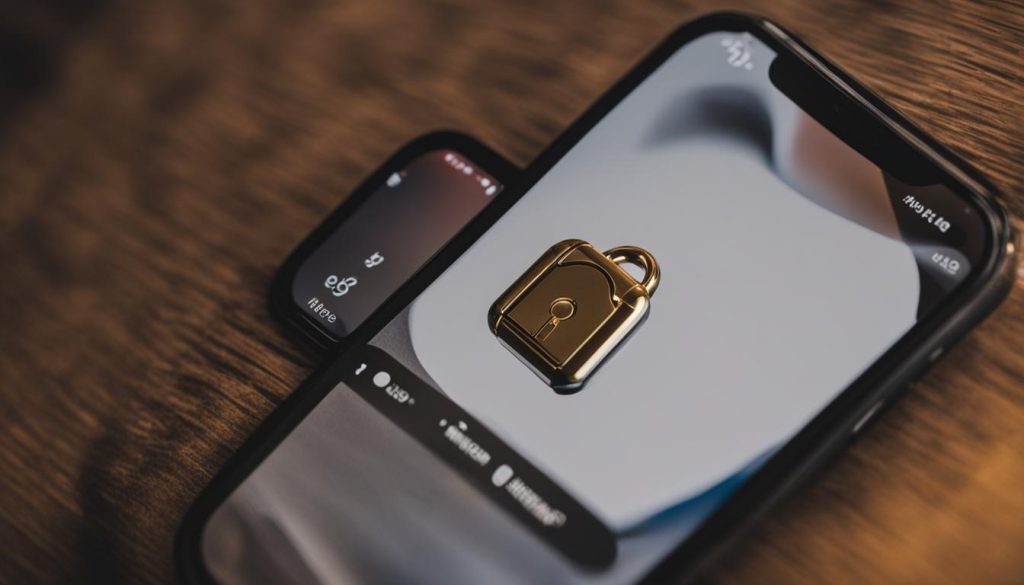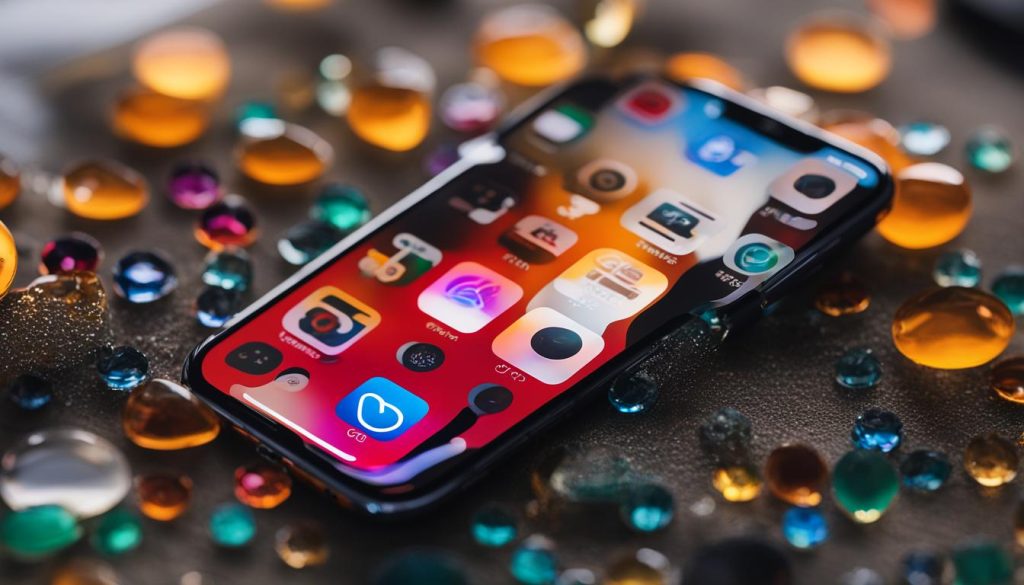I have always been fascinated by the incredible capabilities of iPhones. From their sleek design to their advanced features, iPhones have become an integral part of our lives. However, with the increasing reliance on technology, it is essential to address the potential security risks that come with using these devices.
Have you ever wondered if your iPhone is being hacked? While iPhones are known for their robust security measures, it is still crucial to be vigilant. Hackers are constantly evolving their techniques, and it’s important to stay one step ahead. In this article, I will guide you through the signs of iPhone hacking and provide you with essential tips to protect your device from potential intrusions.
Key Takeaways:
- Unfamiliar apps, unusual messages, excessive data usage, unexpected notifications, erratic performance, and battery drain can be signs of iPhone hacking.
- Regularly update your iPhone software, use mobile device management tools, and educate yourself about mobile security best practices to protect your iPhone.
- Secure your connections, enable two-factor authentication, and monitor device activity for enhanced iPhone security.
The Importance of iPhone Security and Privacy
iPhones are renowned for their strong built-in security features, which make them a popular choice among users concerned about their privacy and data protection. The closed nature of the Apple ecosystem, along with the company’s focus on security, helps prevent the distribution of malware through the official App Store. Additionally, iOS and macOS employ encryption, secure boot processes, and containerization to safeguard against security threats, providing users with peace of mind when it comes to their personal information.
However, despite these robust security measures, it is still important for iPhone users to take precautions to ensure the security and privacy of their devices. By implementing additional security measures and following best practices, they can further enhance the protection of their iPhones against potential hacking attempts and data breaches.
Protecting Your iPhone
There are several steps that iPhone users can take to protect their devices and maintain their security:
- Regularly update your iPhone’s software to ensure you have the latest security patches and bug fixes. Software updates often include important security enhancements designed to address potential vulnerabilities.
- Use trusted sources when downloading apps and avoid installing unfamiliar or unverified applications that may contain malware or malicious code.
- Enable two-factor authentication, which adds an extra layer of security by requiring users to provide two forms of authentication to access their accounts or devices.
- Implement mobile device management (MDM) tools to enforce security policies, compliance settings, and remote management of iPhones in an organizational setting. MDM tools can help monitor device activity, push security updates, and detect and prevent threats in real time.
- Educate yourself and end users about mobile security best practices, such as being cautious of phishing attempts, suspicious links, and unsolicited messages.
- Regularly monitor your iPhone’s device activity and be aware of any unusual behavior or unusual data usage that could indicate a potential security breach.
By following these security measures, iPhone users can strengthen the security of their devices, protect their privacy, and minimize the risk of hacking and data breaches.
Common Signs of iPhone Hacking
As iPhones become more prominent in our daily lives, it’s crucial to be aware of the signs that your device may have been hacked. Detecting iPhone hacking early can help protect your personal information and prevent further security breaches. Here are some common indicators of iPhone hacking that you should be aware of:
- Presence of unfamiliar apps or programs: If you notice any applications or programs on your iPhone that you don’t remember installing or that you don’t recognize, it could be a sign that your device has been compromised.
- Unfamiliar messages being sent or received: Keep an eye out for any unusual messages appearing in your messaging apps. If you receive or send messages that you don’t remember initiating, it could indicate unauthorized access to your iPhone.
- Excessive data usage: If you notice a significant increase in your data usage without any reasonable explanation, it’s worth investigating further. Hackers may use your iPhone to perform data-intensive tasks without your knowledge.
- Unusual battery drain: While battery drain can occur due to various factors, such as heavy usage or age, sudden and significant battery depletion could be a sign of malware running in the background.
- Unexpected notifications: If you receive unexpected notifications from unfamiliar sources or apps, it could be a sign that your iPhone has been compromised.
- Erratic performance or crashes: If your iPhone starts behaving unpredictably, such as freezing, crashing, or experiencing slow performance without any apparent reason, it may indicate a security breach.
If you notice any of these signs, it’s important to take immediate action to remove any potential malware or suspicious software from your device. Additionally, consider consulting with a cybersecurity professional to ensure that your iPhone is secure and to prevent future hacking attempts.
Table: Comparison of Common Signs of iPhone Hacking
| Signs of iPhone Hacking | Indicators |
|---|---|
| Presence of unfamiliar apps or programs | Applications or programs you don’t recognize or remember installing |
| Unfamiliar messages being sent or received | Unusual messages appearing in messaging apps |
| Excessive data usage | Significant increase in data usage without explanation |
| Unusual battery drain | Sudden and significant depletion of battery life |
| Unexpected notifications | Notifications from unfamiliar sources or apps |
| Erratic performance or crashes | Freezing, crashing, or slow performance without apparent reason |
Being vigilant and proactive in detecting iPhone hacking signs is crucial for protecting your personal data and maintaining the security of your device. By staying informed about the indicators of iPhone hacking and taking necessary precautions, you can ensure a safer digital experience.
How to Protect Your iPhone From Hacking
In today’s digital age, ensuring the security of your iPhone is of utmost importance. With the growing sophistication of hacking techniques, it is crucial to take proactive measures to protect your device and personal information. By following these iPhone security best practices, you can minimize the risk of falling victim to hacking attempts.
Regularly Update Your iPhone Software
One of the most effective ways to protect your iPhone from hacking is by regularly updating its software. Software updates often include important security patches that address known vulnerabilities. By keeping your iPhone up to date, you ensure that it is equipped with the latest defense mechanisms against potential hacking attempts. To update your iPhone software, go to Settings > General > Software Update and follow the prompts to install any available updates.
Use Mobile Device Management (MDM) Tools
Implementing mobile device management (MDM) tools can greatly enhance the security of your iPhone. MDM tools enable you to enforce security policies and compliance settings on your device, such as password requirements, app restrictions, and remote data wiping. By utilizing MDM tools, you can have greater control over your iPhone’s security and protect it from unauthorized access or use.
Be Cautious of Unfamiliar Apps and Messages
Downloading apps and opening messages from unknown sources can leave your iPhone vulnerable to hacking. It is important to exercise caution when installing apps and only download them from trusted sources such as the official App Store. Additionally, be wary of suspicious messages, especially those that contain links or ask for personal information. Avoid clicking on unfamiliar links and never disclose sensitive data to unknown senders.
Enable Two-Factor Authentication
Two-factor authentication adds an extra layer of security to your iPhone by requiring you to provide two forms of authentication to access your accounts or devices. By enabling this feature, you ensure that even if someone gains access to your password, they would still need a secondary form of authentication, such as a unique code sent to your trusted device, to log in. To enable two-factor authentication on your iPhone, go to Settings > Passwords & Accounts > Two-Factor Authentication and follow the setup process.
By following these iPhone security measures and best practices, you can significantly reduce the risk of your device being hacked. It is important to stay vigilant and proactive in protecting your iPhone to safeguard your personal data and maintain the integrity of your device.
The Role of Jailbreaking in iPhone Security
Jailbreaking an iPhone can pose significant security risks. When an iPhone is jailbroken, it means that the device’s operating system has been modified to remove restrictions imposed by Apple. While jailbreaking can provide users with more customization options and access to unauthorized third-party apps, it also exposes the iPhone to potential security vulnerabilities. Here, we explore the risks associated with jailbreaking and why it is important to avoid compromising the security of your iPhone.
One of the main dangers of jailbreaking an iPhone is the increased susceptibility to malware. Jailbroken devices are more vulnerable to malicious software, as the altered system can allow malware to bypass Apple’s built-in security measures. This puts your personal data, such as passwords, financial information, and private communications, at risk of being accessed by unauthorized individuals.
To check if your iPhone has been jailbroken, look out for unfamiliar applications and unknown profiles installed on your device. These could be indicators that your iPhone’s security has been compromised. Additionally, regularly rebooting your iPhone can help eliminate any hacks or jailbreaks that may have occurred.
In conclusion, jailbreaking your iPhone can have serious implications for its security and the safety of your personal information. It is strongly recommended to avoid jailbreaking your device and instead rely on the robust security measures built into the iPhone’s operating system. By staying within Apple’s authorized ecosystem, you can ensure the highest level of protection for your iPhone and safeguard your data from potential threats.
The Risks of Jailbreaking
“Jailbreaking an iPhone can provide users with more customization options and access to unauthorized third-party apps, but it also exposes the device to potential security vulnerabilities. by removing important security features, jailbreaking increases the risk of malware and unauthorized access to personal data.”
Jailbreaking Indicators
- Unfamiliar applications installed on the device
- Unknown profiles present on the iPhone
Protecting Your iPhone
- Avoid jailbreaking your device
- Regularly reboot your iPhone
- Follow recommended security measures provided by Apple
| Jailbreaking Risks | Recommended Actions |
|---|---|
| Increased vulnerability to malware | Avoid jailbreaking your iPhone |
| Potential unauthorized access to personal data | Regularly reboot your device |
| Compromise of built-in security features | Follow Apple’s recommended security measures |
Importance of Regular Updates and Software Maintenance
Regularly updating your iPhone’s software is crucial for maintaining its security. Software updates often include security patches that address vulnerabilities and protect against hacking attempts. By keeping your iPhone updated with the latest software, you can ensure that your device has the necessary defenses to safeguard your personal and sensitive information.
iOS updates are released periodically by Apple to address security vulnerabilities, improve performance, and add new features to your iPhone. These updates are designed to enhance the overall user experience and protect against emerging threats. Keeping your iPhone up to date with the latest iOS version is essential for maintaining optimal security.
Security patches are specifically developed to fix vulnerabilities that hackers may exploit to gain unauthorized access to your device or steal your data. These patches help to close security loopholes and ensure that your iPhone is protected against known threats. By applying security patches as soon as they become available, you can effectively fortify your iPhone’s defenses and minimize the risk of hacking.
| Benefits of Regular Updates and Software Maintenance |
|---|
| 1. Enhanced Security: Regular updates and software maintenance help to protect your iPhone from the latest security threats. |
| 2. Bug Fixes: Updates often include bug fixes that improve the performance and stability of your device. |
| 3. New Features: Software updates can introduce new features and functionalities to enhance your iPhone experience. |
| 4. Compatibility: Staying updated ensures compatibility with the latest apps and services. |
In addition to software updates, it is also important to regularly maintain your iPhone by cleaning up unnecessary files and optimizing its performance. This can be done by deleting unused apps, clearing cache, and organizing your files. By keeping your iPhone clutter-free and running smoothly, you can reduce the risk of potential security vulnerabilities and ensure a seamless user experience.
By prioritizing regular updates and software maintenance, you are taking proactive measures to protect your iPhone and keep it secure. Stay vigilant and make sure to enable automatic updates on your device to ensure that you always have the latest security patches. Remember, a well-maintained iPhone is a secure iPhone.
The Role of Mobile Device Management (MDM) in iPhone Security
Mobile Device Management (MDM) plays a crucial role in ensuring the security of iPhones in an organizational setting. MDM tools enable organizations to enforce security policies, compliance settings, and remote management of iPhones, providing a comprehensive solution to protect sensitive data and prevent security breaches.
With MDM, organizations can monitor device activity, push security updates, and detect and prevent threats in real time. By implementing an MDM solution, IT administrators gain enhanced visibility into the devices, enabling them to proactively identify and address any potential security issues. This ensures that iPhones are protected against malware, unauthorized access, and other security threats.
Furthermore, MDM allows organizations to enforce security policies on iPhones, ensuring that employees adhere to best practices and comply with industry regulations. MDM tools can restrict access to certain apps or websites, enforce strong device passcodes, and remotely wipe devices in case of loss or theft, further enhancing the overall security of iPhones in the workplace.
Benefits of Mobile Device Management (MDM) for iPhone Security
- Enhanced security: MDM tools provide organizations with the ability to enforce security policies, ensuring that iPhones are protected against potential threats.
- Real-time threat detection: MDM solutions can detect and prevent security threats in real time, allowing IT administrators to take immediate action to mitigate risks.
- Remote management: MDM enables remote management of iPhones, allowing administrators to push security updates, enforce compliance settings, and monitor device activity from a centralized console.
- Improved compliance: By enforcing security policies and compliance settings, MDM helps organizations meet industry regulations and protect sensitive data.
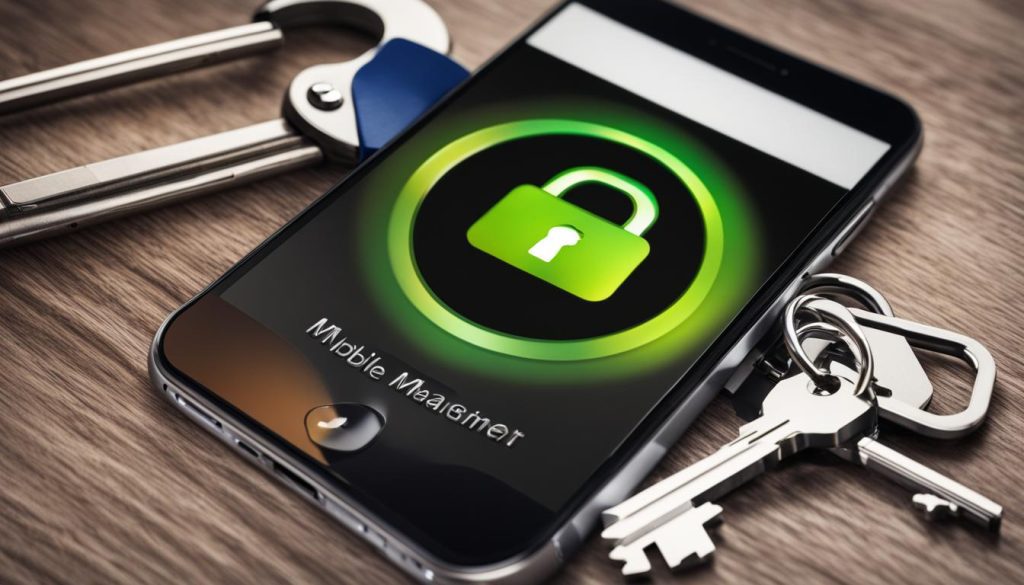

In conclusion, Mobile Device Management (MDM) plays a critical role in enhancing the security of iPhones in an organizational setting. By enforcing security policies, remotely managing devices, and providing real-time threat detection, MDM tools enable organizations to protect sensitive data, prevent security breaches, and ensure compliance with industry regulations.
Importance of User Education and Training
In order to maintain a secure environment for our iPhones, it is crucial to educate ourselves and end users about iPhone security best practices. By understanding the risks associated with unfamiliar apps, messages, and websites, we can better protect our devices and personal information.
One of the key aspects of user education is recognizing and avoiding phishing attempts. Users should be cautious of suspicious links and be aware of the potential consequences of clicking on them. By emphasizing the importance of verifying the authenticity of sources and not sharing sensitive information with unknown parties, we can mitigate the risk of falling victim to phishing attacks.
Additionally, training should focus on the importance of regularly updating the iPhone’s software. By staying up to date with the latest security patches and software versions, we can ensure that our devices have the necessary protection against emerging threats. Training materials should provide clear instructions on how to check for software updates and encourage users to install them promptly.
Mobile Security Best Practices:
- Be cautious of unfamiliar apps, messages, and websites
- Avoid clicking on suspicious links and sharing sensitive information
- Regularly update your iPhone’s software to ensure the latest security patches
- Enable two-factor authentication for an extra layer of security
- Use strong, unique passwords for your accounts
“Education is the most powerful weapon which you can use to change the world.” – Nelson Mandela
| Key Training Topics | Summary |
|---|---|
| Recognizing phishing attempts | Teach users to be cautious of suspicious links and verify the authenticity of sources before sharing sensitive information. |
| Software updates | Highlight the importance of regularly updating the iPhone’s software to ensure the latest security patches are in place. |
| Two-factor authentication | Encourage users to enable two-factor authentication for an additional layer of security when accessing accounts. |
| Strong passwords | Emphasize the importance of using strong, unique passwords for all accounts to prevent unauthorized access. |
By providing comprehensive user education and training, we can empower individuals to take an active role in ensuring the security of their iPhones. With a well-informed user base, we can collectively create a safer digital ecosystem for all.
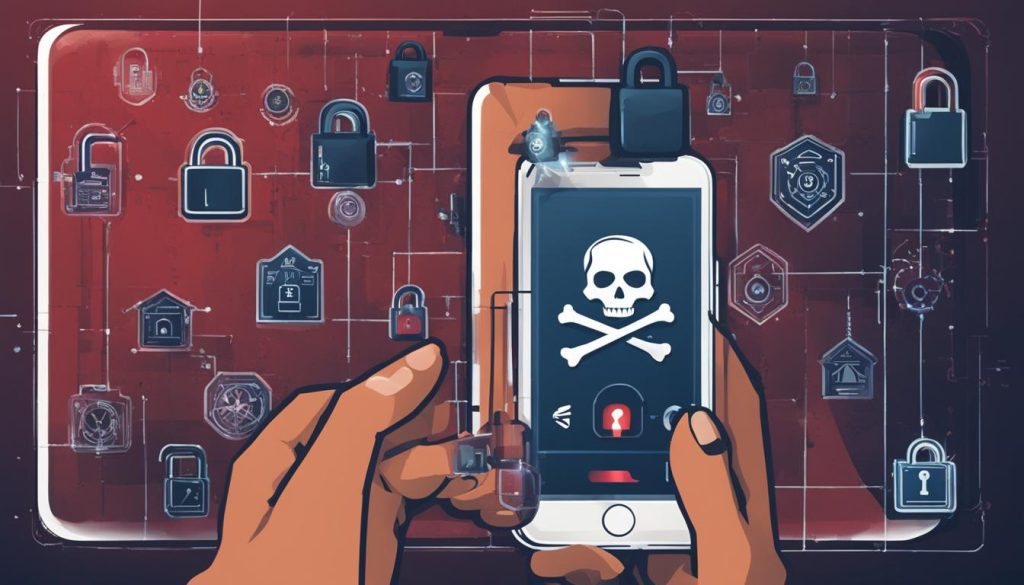

Secure Connections and Two-Factor Authentication
When it comes to using your iPhone on public Wi-Fi networks, prioritizing secure connections is crucial. Connecting only to trusted sources and avoiding sharing sensitive information can help protect your data from potential hacking attempts. By utilizing mobile device management (MDM) tools, organizations can establish secure per-app VPN connections for iPhones, ensuring that data transmitted over public networks remains encrypted and secure.
One effective way to enhance the security of your iPhone is by enabling two-factor authentication. This authentication method adds an extra layer of protection by requiring users to provide two forms of authentication to access their accounts or devices. By combining something the user knows (like a password) with something the user has (like a verification code sent to their phone), two-factor authentication significantly reduces the risk of unauthorized access to your iPhone and associated accounts.
To enable two-factor authentication on your iPhone, follow these steps:
- Go to Settings on your iPhone.
- Tap on your Apple ID at the top of the screen.
- Select Password & Security.
- Tap on Two-Factor Authentication.
- Follow the on-screen instructions to set up two-factor authentication for your Apple ID.
By taking these steps to ensure secure connections and enabling two-factor authentication, you can significantly enhance the security of your iPhone and protect your sensitive information from potential threats.
Importance of Monitoring Device Activity
Monitoring device activity is a crucial aspect of maintaining the security of your iPhone. By keeping a close eye on the behavior and usage patterns of your device, you can proactively detect and address any potential security threats. This proactive approach allows you to take the necessary steps to protect your personal information and prevent any unauthorized access to your iPhone.
One effective way to monitor device activity is by utilizing Mobile Device Management (MDM) tools. These tools provide detailed reporting on various aspects of your iPhone’s usage, such as the applications installed, network connections, and system performance. MDM reporting enables you to have a comprehensive overview of your device’s activity and allows you to identify any suspicious behavior or unauthorized access attempts.
With the help of MDM reporting, you can detect and respond to potential iPhone threats in real time. By leveraging the insights provided by these tools, you can quickly take the necessary actions to mitigate any security risks. This may include blocking or removing suspicious applications, revoking access to compromised accounts, or initiating a remote wipe of the device if necessary.
By regularly monitoring your iPhone’s device activity and leveraging the capabilities of MDM tools, you can stay one step ahead of potential security threats. This proactive approach to device security ensures that you can protect your personal data, maintain the confidentiality of sensitive information, and enjoy the peace of mind that comes with a secure iPhone.
Table: Summary of iPhone Threat Detection Techniques
| Threat Detection Technique | Description |
|---|---|
| Application Activity Monitoring | Monitoring and analyzing the behavior of installed applications to detect any suspicious or malicious activities. |
| Network Traffic Analysis | Examining network connections and data transfers to identify any unauthorized or suspicious network activity. |
| System Integrity Checks | Regularly scanning and verifying the integrity of system files and configurations to detect any unauthorized modifications. |
| User Behavior Analytics | Analyzing user behavior patterns and deviations to identify any abnormal activities that may indicate a security breach. |
| Anomaly Detection | Using machine learning algorithms to identify and flag any abnormal or anomalous behavior patterns that may indicate a security threat. |
Table: Summary of iPhone Threat Detection Techniques
Removing Malware from an Infected iPhone
If you suspect that your iPhone has been infected with malware, it is crucial to take immediate action to remove it and prevent further damage to your device and data. Here are some steps you can follow to remove malware from an infected iPhone:
- Check for Jailbreak: Begin by checking if your iPhone has been jailbroken. Jailbreaking can make your device more vulnerable to malware. Look for unfamiliar apps or programs on your device, as well as unknown profiles that may have been installed. If you find any, uninstall them immediately.
- Update Software: Updating your iPhone’s software to the latest version can help address any vulnerabilities and security flaws that may have been exploited by malware. Install the latest software updates as soon as they become available to ensure that you have the most up-to-date protection.
- Perform a Factory Reset: In severe cases where the malware infection is persistent or cannot be removed through other means, performing a factory reset may be necessary. A factory reset will restore your iPhone to its original settings, effectively removing any malware or suspicious software. However, it is important to note that performing a factory reset will erase all data on your device, so be sure to backup your important files and data before proceeding.
By following these steps, you can effectively remove malware from your infected iPhone and minimize the risk of further damage. It is important to stay vigilant and take proactive measures to protect your device from malware and other security threats.
Remember to always exercise caution when downloading apps or clicking on links, and be wary of any suspicious or unfamiliar activities on your iPhone. Regularly updating your software and being mindful of security best practices can go a long way in keeping your device safe and secure.
| Step | Action |
|---|---|
| 1 | Check for Jailbreak |
| 2 | Update Software |
| 3 | Perform a Factory Reset |
Conclusion
Protecting your iPhone and ensuring its security is essential in safeguarding your personal and sensitive information. By following the recommended secure iPhone practices, you can significantly reduce the risk of hacking and data breaches.
Regularly updating your iPhone’s software is crucial for staying ahead of potential security vulnerabilities. By keeping your device up to date, you can benefit from the latest security patches and protect against emerging threats.
In addition to software updates, using mobile device management (MDM) tools can enhance iPhone security. MDM enables organizations to enforce security policies, monitor device activity, and detect and prevent threats in real time.
Educating yourself and end users about iPhone security best practices is also crucial. By being aware of the risks associated with unfamiliar apps, messages, and websites, you can avoid potential hacking attempts and protect your device and data.
By implementing these security measures and staying vigilant, you can maintain a secure iPhone environment and protect your valuable information from unauthorized access.
FAQ
How do you know if your iPhone is being hacked?
There are several signs that can indicate if your iPhone has been hacked, including the presence of unfamiliar apps, unusual messages being sent or received, excessive data usage, unexpected notifications, erratic performance, and battery drain.
What are the common signs of iPhone hacking?
Common signs of iPhone hacking include the presence of unfamiliar apps or programs, unfamiliar messages being received or sent, excessive data usage, unusual battery drain, unexpected notifications, and erratic performance or crashes.
How can I protect my iPhone from hacking?
To protect your iPhone from hacking, you should regularly update the software, use mobile device management (MDM) tools, educate end users about mobile security best practices, connect to trusted sources, enable two-factor authentication, and monitor device activity.
What is the role of jailbreaking in iPhone security?
Jailbreaking an iPhone can pose significant security risks as it provides malware with easy access to the device. It is important to avoid jailbreaking your iPhone to maintain its security and protect your data.
Why is regular software update important for iPhone security?
Regularly updating your iPhone’s software is crucial for maintaining its security. Software updates often include security patches that address vulnerabilities and protect against hacking attempts.
What is the role of mobile device management (MDM) in iPhone security?
Mobile device management (MDM) tools enable organizations to enforce security policies, compliance settings, and remote management of iPhones. They can help monitor device activity, push security updates, and detect and prevent threats in real time.
How important is user education and training for iPhone security?
Educating end users about iPhone security best practices is essential for maintaining a secure environment. Users should be aware of the risks associated with unfamiliar apps, messages, and websites.
How can I establish secure connections and enhance iPhone security?
When accessing public Wi-Fi networks, it is important to connect only to trusted sources and avoid sharing sensitive information. Enabling two-factor authentication adds an extra layer of security.
Why is monitoring device activity important for iPhone security?
Monitoring device activity is crucial for identifying and addressing potential security threats on iPhones. Mobile device management (MDM) tools can generate reports on device application inventory, detect suspicious behavior, and provide real-time protection against malicious apps and network attacks.
How can I remove malware from an infected iPhone?
If your iPhone is infected with malware, you should check if it is jailbroken, uninstall unfamiliar apps or programs, update to the latest software version, and in severe cases, perform a factory reset. It is crucial to backup your data before performing a factory reset to prevent data loss.


